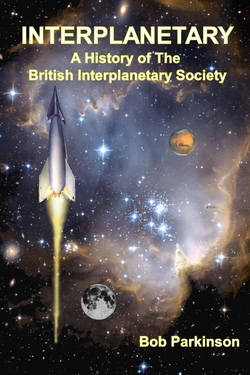Centauri Dreams
Imagining and Planning Interstellar Exploration
A SETI Search of 10 Million Star Systems
As it is considered a precursor installation, the Murchison Widefield Array (MWA) in Western Australia doesn’t get the press that its proposed successor, the Square Kilometer Array (SKA) regularly receives. That’s to be expected, given the scope of the SKA, which will involve telescopes in both Australia and South Africa. 14 member countries are developing a project that is to reach over a square kilometer of collecting area, containing thousands of dishes and up to a million low-frequency antennas. If it is built, SKA’s angular resolution and survey speed will allow surveys thousands of times faster than those now being conducted.
But the Murchison precursor is alive and well, working the 70-300 MHz range and mapping the radio sky. Established by a consortium of universities — MIT, Swinburne, Curtin and Australian National University — the telescope is located on a site selected by these universities and managed by Curtin University. CSIRO, Australia’s national science agency, would later take over management of the site, which also now houses their SKA precursor instrument, ASKAP.
The MWA may be 50 times less sensitive than the SKA, but it has been put to work in areas ranging from the heliosphere to neutral hydrogen emission from the early universe. Its remit also includes several SETI studies, the latest being a search in the area of the constellation Vela (originally part of the larger Argo Navis constellation). The International Centre for Radio Astronomy Research calls this latest survey “the deepest and broadest search at low frequencies for alien technologies.” The results are now in the books, as reported in Publications of the Astronomical Society of Australia.
CSIRO astronomers Chenoa Tremblay and Steven Tingay (Curtin University) used the telescope’s wide field of view to observe millions of stars simultaneously. No technosignatures were detected, leading Tingay to observe:
“As Douglas Adams noted in The Hitchhikers Guide to the Galaxy, ‘space is big, really big’. And even though this was a really big study, the amount of space we looked at was the equivalent of trying to find something in the Earth’s oceans but only searching a volume of water equivalent to a large backyard swimming pool. Since we can’t really assume how possible alien civilisations might utilise technology, we need to search in many different ways. Using radio telescopes, we can explore an eight-dimensional search space. Although there is a long way to go in the search for extraterrestrial intelligence, telescopes such as the MWA will continue to push the limits—we have to keep looking.”

The scientists observed the sky in Vela for 17 hours, and point to the capabilities of the coming SKA, which if completed could be available late in this decade. SKA would extend the SETI search into billions of star systems, and would be capable of detecting what Tingay calls “Earth-like radio signals” from relatively nearby planetary systems, meaning, I assume, leakage radiation as opposed to directed signals designed to be interstellar. The current work follows earlier MWA surveys, one toward galactic center, the other in the anti-center direction.
From the paper:
Overall, our MWA surveys show the rapid progress that can currently be made in SETI at radio frequencies, using wide field and sensitive facilities, but also show that SETI surveys have a long way to go. The continued use of the MWA, and the future similar use of the SKA at much higher sensitivities, offers a mechanism to make significant cuts into the haystack fraction of Wright et al. (2018), while maintaining a primary focus on astrophysical investigations, making excellent commensal use of these large-scale facilities.
Image: Dipole antennas of the Murchison Widefield Array (MWA) radio telescope in Western Australia. Credit: Dragonfly Media.
On the matter of ‘haystack fractions,’ the phrase comes from a 2018 paper from Jason Wright (Penn State) and co-authors (two students in a graduate SETI course taught by Wright), which attempts to calculate the total fraction of the ‘haystack’ that has been searched to date, producing a result not far off what Jill Tarter calculated back in 2010: “…our current search completeness is extremely low, akin to having searched something like a large hot tub or small swimming pool’s worth of water out of all of Earth’s oceans.” Tarter’s comparison was to a drinking glass’s worth of seawater, so we’re in the same range.
Although I cited it in an earlier article (see Into the Cosmic Haystack) this quotation from the Wright et al. paper bears repeating:
We should be careful, however, not to let this result swing the pendulum of public perceptions of SETI too far the other way by suggesting that the SETI haystack is so large that we can never hope to find a needle. The whole haystack need only be searched if one needs to prove that there are zero needles—because technological life might spread through the Galaxy and/or technological species might arise independently in many places, we might expect there to be a great number of needles to be found. Also, our haystack definition included vast swaths of interstellar space where we have no particular reason to expect to find transmitters; humanity’s completeness to subsets of this haystack—for instance, for continuous, permanent transmissions from nearby stars—is many orders of magnitude higher.
Noting that “the dream of ‘all-sky, all the time” high bandwidth coverage is still worth pursuing, and singling out the Tingay et al surveys at the MWA in particular, Wright and colleagues say that surveys with large bandwidth, long exposures, repeat visits and good sensitivity allow for searches that are orders of magnitude faster than surveys without these qualities. Indeed, the three MWA low frequency surveys, because of their very wide field and sensitivity, dominate the haystack search volume, and as Wright notes, they did this in only a few hours of searching. The paper also notes how rapidly Breakthrough Listen is cutting into this search space, and that was before the most recent Breakthrough results were announced (see SETI: Going Deep with the Data Search).

Image: A 20-second exposure showing the Milky Way overhead the AAVS station. Credit: Michael Goh and ICRAR/Curtin.
The paper is Tremblay and Tingay, “A SETI Survey of the Vela Region using the Murchison Widefield Array: Orders of Magnitude Expansion in Search Space”, Publications of the Astronomical Society of Australia September 8th, 2020 (abstract). The Wright paper is “How Much SETI Has Been Done? Finding Needles in the n-Dimensional Cosmic Haystack,” Astronomical Journal Vol. 156, No. 6 (14 November 2018). Abstract / Preprint.

Solaris: To the Sun’s High Latitudes
I can think of more than one way to get a good look at the Sun’s polar regions. After all, we’ve done it before, through the Ulysses spacecraft, which passed over the Sun’s north and south poles in 1994-1995. A gravity assist at Jupiter was the key to the mission, allowing Ulysses to arc out of the ecliptic and inward to the Sun. But Ulysses lacked the kind of remote-sensing instruments we’d like to use to compile an extensive dataset on the polar magnetic field and, as Don Hassler (SwRI) adds, “the surface/sub-surface flows” we might find in the polar regions. It’s good to see a mission designed for that purpose.
For Hassler is principal investigator on a concept that has just been approved for further study by NASA, with the haunting name Solaris. I say ‘haunting’ because it’s hard for this Stanislaw Lem reader to forget the novel of the same name, published in 1961, that explores the implications of a vast intelligence on a planet far from Earth. I realize this has been done as a film more than once and I’ve seen the films, but I leave their analysis to Centauri Dreams film critic Larry Klaes, who would know how to do justice to them. For me, the written word is the medium of choice, and this is a novel I intend to read again.
Anyway, the proposed Solaris mission is one of five science investigations just approved by NASA as part of the agency’s Medium-Class Explorer (MIDEX) program, with $1.25 million allocated for a nine-month contract for what are known as Phase A concept design studies and analyses to develop the concept. If it flies, Solaris would launch in 2025, like Ulysses using a gravity assist at Jupiter to sling it out of the ecliptic plane, flying over the solar poles at 75 degrees latitude. You might think of the surprises Cassini found at Saturn’s poles, and that odd hexagon at the north pole is still the subject of various competing hypotheses. Will we find something just as odd at the Sun? Hassler notes that we’ll at least get a good look:
“Solaris will spend more than three months over each pole of the Sun, obtaining the first continuous, high-latitude, months-long studies of the Sun’s polar regions. With focused science and a simple, elegant mission design, Solaris will also provide enabling observations for space weather research, such as the first polar views of coronal mass ejections, energetic events that spew highly magnetized plasma from the solar corona into space, causing radio and magnetic disturbances on the Earth.”
And. he adds, “It’s sure to stimulate future research through new unanticipated discoveries.”
Unexpected findings have characterized our explorations of the Solar System from the beginning, with Io and Triton being two outstanding examples, so let’s see what those solar polar regions look like. We’ll keep an eye on the progress of Solaris as it makes its way through the process. The concept calls for a Doppler magnetograph to study the polar magnetic fields and subsurface flows, along with an extreme ultraviolet instrument for polar imaging and a white light coronagraph to examine the solar corona from this perspective.
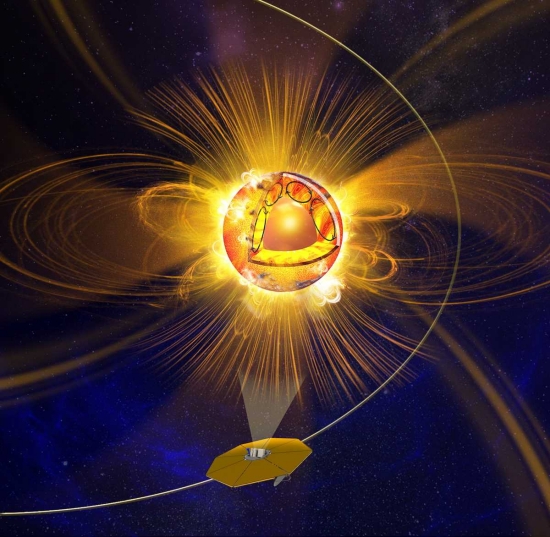
Image; Southwest Research Institute is developing the concept for a mission to study the Sun’s poles, one of the last unseen places in the solar system. This proposed solar polar NASA mission is designed to revolutionize our understanding of the Sun by addressing fundamental questions that can only be answered from a polar vantage point. Credit: Courtesy of Southwest Research Institute.
And keep an eye on another mission funded for similar Phase A concept design study, the Auroral Reconstruction CubeSwarm (ARCS), in the hands of principal investigator Kristina Lynch (Dartmouth University), a mission that would, like Solaris, be managed by SwRI. For me, the chief interest of ARCS is in its plan for 32 CubeSats and 32 ground-based observatories to work together, in this case on a study of the mechanisms driving Earth’s auroras. CubeSat designs of growing complexity are low-cost ways to fly ever more interesting missions, and the emerging notion of ‘swarm’ missions should turn out to be productive in areas as diverse as planetary imaging and extrasolar planet detection.
Meanwhile, I’m always glad to see continuing interest in missions to the Sun, given our need to understand the issues involved in close solar approaches for potential ‘sundiver’ missions deep into the gravity well for maximum acceleration to targets in the outer system. I’ll also mention Solar Cruiser as a fascinating sail design that could enable study of the Sun’s high latitudes using non-Keplerian orbits enabled by the momentum of solar photons. Principal investigator Les Johnson (MSFC) sees this as an outstanding opportunity to demonstrate the capabilities of large sails as we explore the nearest star in the cosmos.
For more on Solar Cruiser, see Heliophysics with Interstellar Implications. See also Johnson’s analysis “The Solar Cruiser Mission Concept — Enabling New Vistas for Heliophysics,” Bulletin of the American Astronomical Society, Vol. 52, No. 3 (June, 2020). Abstract.

A Deformed Protoplanetary Disk in a Triple Star System
This morning we have two interesting and complementary studies of GW Orionis to look at, both analyzing what is apparently a planet-forming disk with multiple, misaligned rings around this triple star system some 1300 light years from the Sun. In the more recent of the two, Stefan Kraus (University of Exeter) and colleagues used data from both the Atacama Large Millimeter/submillimeter Array (ALMA) and the European Observatory’s Very Large Telescope (VLT) in detecting warm gas at the inner edge of the misaligned ring, which has broken away from the larger disc, and scattered light from the warped disk surface.
So what could be going on at GW Orionis? What the images reveal is an evolving young system much different from our own. Consider: The inner stars GW Ori A and GW Ori B orbit each other at a separation of a scant 1 AU, while the third star, GW Ori C, orbits the inner stars at a distance of roughly 8 AU, the latter in an orbit that is not aligned with the plane of the inner duo. In our Solar System, we’re used to planets that move in roughly the same plane around the Sun. Here we see a deformed protoplanetary disk that may produce an utterly different result.
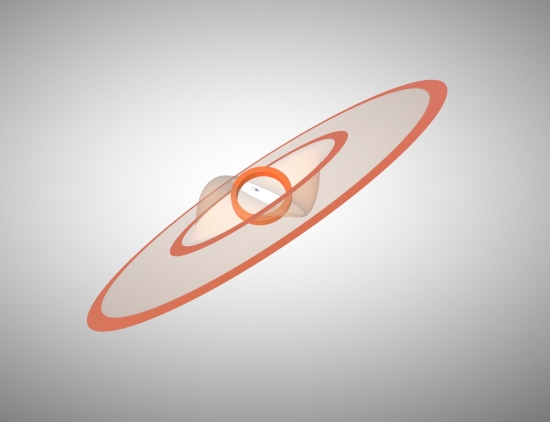
Image: Representation of the disc structure and stellar orbit of the GW Orionis triple system, as derived from the ALMA and VLT observations by Kraus et al. Orange rings are the (misaligned) rings seen by ALMA. The transparent surfaces correspond to the lower-density dust filaments that connect the rings and that dominate the emission in scattered light. Credit: Kraus et al., 2020; NRAO/AUI/NSF.
What an intriguing place to study planet formation, and to ponder scenarios as the system evolves. The ALMA data reveal three separate rings with different orientations, located at 46, 185 and 340 AU from the barycenter of the system. The inner ring is misaligned in relation not only to the outer two rings but also to the three stars. Says Kraus:
“In our images, we see the shadow of the inner ring on the outer disk. At the same time, ALMA allowed us to measure the precise shape of the ring that casts the shadow. Combining this information allows us to derive the 3-dimensional orientation of the misaligned ring and of the warped disk surface.”
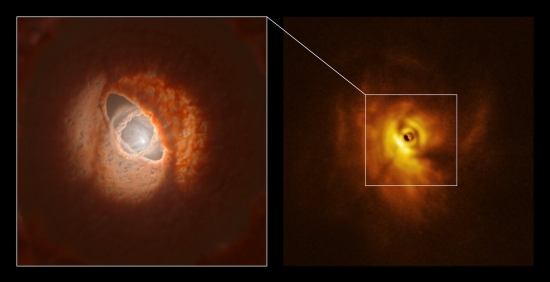
Image: New observations of GW Orionis, a triple star system with a peculiar inner region, revealed that this object has a warped planet-forming disk with a misaligned ring. The image on the right is from the SPHERE instrument on the European Southern Observatory’s Very Large Telescope, which allowed astronomers to see, for the first time, the shadows this ring casts on the rest of the disk. This helped the researchers figure out the 3D shape of the ring and the overall disk. The left panel shows an artistic impression of the disk’s inner region, including the ring, which is based on the 3D shape reconstructed by the team. Credit: ESO/L. Calçada, Exeter/Kraus et al.
Planets could well emerge here, with the research indicating that the inner ring contains about 30 Earth masses of dust. What’s intriguing is that any planets forming within this inner ring will orbit in a highly oblique fashion at wide separation from the star. Bear in mind that it’s now believed that more than half of the stars in the galaxy are born with one or more companion stars, making for the prospect of a large population of planets on highly inclined, distant orbits.
Kraus and team have been examining GW Orionis for over 11 years, mapping the gravitational interactions at work among the three stars over a full orbital period. It is clear that the stellar orbits are misaligned from each other and from the disk. We’re getting confirmation here through both observations and computer simulations that a theoretical ‘disk tearing effect’ is in play, one that emerges out of the gravitational pull of the three stars and causes the disk to break into separate rings. Observation of the shadow that the inner ring casts upon the rest of the disk was useful in calculating the shape of the ring and the overall disk structure. Moreover, the shape of the inner ring matches predictions of precisely how gravitational interactions would tear the original disk.
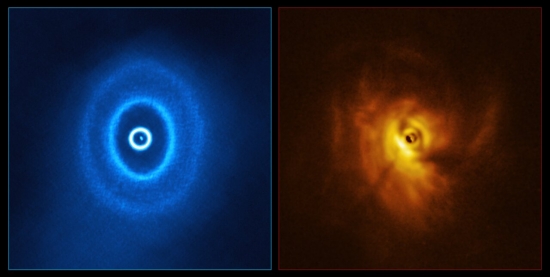
Image; ALMA and the SPHERE instrument on ESO’s Very Large Telescope have imaged GW Orionis, a triple star system with a peculiar inner region. Unlike the flat planet-forming discs we see around many stars, GW Orionis features a warped disc, deformed by the movements of the three stars at its centre. The ALMA image (left) shows the disc’s ringed structure, with the innermost ring separated from the rest of the disc. The SPHERE observations (right), repeated here for comparison, allowed astronomers to see for the first time the shadow of this innermost ring on the rest of the disc, which made it possible for them to reconstruct its warped shape. Credit: ALMA (ESO/NAOJ/NRAO), ESO/Exeter/Kraus et al.
The second team, led by Jiaqing Bi (University of Victoria, Canada), likewise used data from ALMA to observe the same disk misalignment, publishing their paper in May. This work confirms that the inner ring is misaligned relative to the outer ring and the three stars, with the outer ring being the largest yet observed in disks of this kind. Both teams used computer simulations to examine causes for the misalignment, with the Bi team suggesting a possibility that does not arise in the Klaus paper. This is team member Nienke van der Marel (University of Victoria):
“Our simulations show that the gravitational pull from the triple stars alone cannot explain the observed large misalignment. We think that the presence of a planet between these rings is needed to explain why the disk was torn apart. This planet has likely carved a dust gap and broken the disk at the location of the current inner and outer rings.”
Such a planet would be the first ever observed to orbit three stars. Moreover, it’s clear from the example of GW Orionis that stellar groupings like this can play havoc with the shape of a protoplanetary disk, doubtless producing worlds in highly inclined orbits around multiple stars. “We predict that many planets on oblique, wide-separation orbits will be discovered in future planet imaging campaigns,” says Kraus co-author and Exeter colleague Alexander Kreplin.
The paper is Kraus et al., “A triple star system with a misaligned and warped circumstellar disk shaped by disk tearing” Science Vol. 369, Issue 6508 (4 September 2020), pp. 1233-1238 (abstract). The Bi paper is “GW Ori: Interactions Between a Triple Star System and Its Circumtriple Disk in Action,” Astrophysical Journal Letters Vol. 895, No. 1 (21 May 2020), Abstract.

SETI: Going Deep with the Data Search
What Breakthrough Listen is calling the most comprehensive SETI search to date is now in the books, or at least, the journals, with results accepted and in process at Monthly Notices of the Royal Astronomical Society. Here we are in the realm of data reanalysis, using previously acquired results to serve as a matrix for re-calculation, with the catalog produced by the European Space Agency’s Gaia spacecraft as the key that turns the lock.
No signatures of extraterrestrial technology were detected in the two analyses produced by Breakthrough Listen in 2017 and 2020. The data for these efforts come largely from the Green Bank Telescope (GBT) in West Virginia and the CSIRO Parkes Radio Telescope in Australia, with a focus on 1327 individual stars. Results were published by the Breakthrough Listen science team at UC-Berkeley, and the choice of targets was telling. The search homed in on relatively nearby stars within about 160 light years of the Sun, under the assumption that less powerful transmitters would be detectable the closer they are to the Earth.
The new analysis of these results has been produced by Bart Wlodarczyk-Sroka, a masters student at the University of Manchester (UK) and his advisor Michael Garrett, working with Berkeley SETI director Andrew Siemion. The Manchester duo realized that when one of the large telescopes was pointed at an individual target, the observation also took in a wide range of background stars. This fact meant that stars much further away could be considered if we could make a determination about their distance.
The Gaia catalog measures the distances to over a billion stars. Wlodarczyk-Sroka and Garrett realized that Gaia now gave them measured parallaxes and inferred distances to stars that were found in the full width half-maximum (FWHM) of the main beam of the telescopes used for the Breakthrough Listen observations. FWHM specifies the angular width of the main beam — think of it as the width of the frequency range where less than half the signal’s power is attenuated. Although not targets of the earlier campaign, these numerous stars were available in the data, previously ignored because their distances from Earth were at the time unknown.
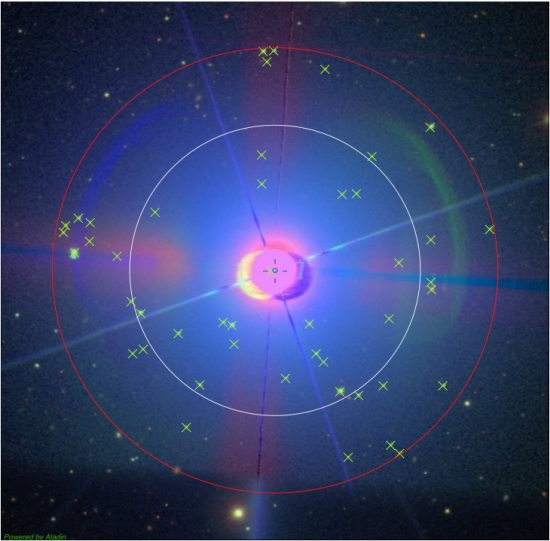
Image: This is Figure 1 from the paper. Caption: . An optical colour image of the stellar field centred on HIP109427 from the Pan-STARRS DR1 z and g broadband filters, showing the extent of the FWHM for the GBT L-band and GBT S-band receivers, circled in red and white respectively. 46 sources with geometric distances calculated from Gaia parallax data are marked with green crosses. Credit: Wlodarczyk-Sroka. Garrett & Siemion.
The Gaia information allowed the researchers to select targets out to 33,000 light years, all found within the original observations, thus expanding the number of stars examined from 1327 to 288,315. Their distance would mean that as the range increased, only more powerful transmitters would be visible to the telescopes. The sample takes in not only many main-sequence stars but extends to giant stars and white dwarfs as well.
Andrew Siemion comments on the significance of the effort:
“This work shows the value of combining data from different telescopes. Expanding our observations to cover almost 220 times more stars would have required a significant investment of our telescope time, not to mention the computing resources to perform the analysis. By taking advantage of the fact that we already had radio scans of stars in the background of our primary targets, and by reading their positions and distances from the Gaia catalog, Bart’s analysis has extracted additional information from the existing dataset. Work like this gets us one step closer to the goal of knowing the answer to humanity’s most profound question: Are we alone?”
Given that the only qualifying criteria for the stars in the new study is that they were within the view of the original observations (i.e., within the FWHM of the telescope beam), the range of stellar types is broad, and this marks the first time scientists have been able to place limits on the prevalence of continuous extraterrestrial transmitters on the basis of spectral type.
In earlier studies, no evidence was found of continuous transmitters associated with stars systems within 50 parsecs of the Sun, given power constraints as explained in the paper:
Both Enriquez et al. (2017) and Price et al. (2020) find no evidence for continuous (100% duty cycle) transmitters associated with the nearby (d < pc) star systems observed. This includes directional transmitters (e.g. radio beacons) directed at the Earth with a power output equal to or greater than the brightest human-made transmitters (e.g. a canonical Arecibo planetary radar-like system with a gain of 70 dB and a transmitter power of ? 1 MW). To detect a non-directional isotropically radiating antenna, the transmitter power must be ? 1013 W (around the current energy consumption of our own civilisation).
We don’t know if any civilizations in this range are broadcasting at all, but the data are consistent with the statement that fewer than ? 0.1% of the stellar systems within 50 pc are using these types of transmitters to contact us. The new work now moves well past the nearby sampling of stars, while factoring in the decrease in sensitivity at larger distances. At 100 to 200 parsecs, for instance, fewer than 0.061 such transmitters can be present, given the same power constraint. We have no candidate signals, but we have hugely widened the scope of the search and tightened the numbers. Wlodarczyk-Sroka comments:
“Our results help to put meaningful limits on the prevalence of transmitters comparable to what we ourselves can build using 21st century technology. We now know that fewer than one in 1600 stars closer than about 330 light years host transmitters just a few times more powerful than the strongest radar we have here on Earth. Inhabited worlds with much more powerful transmitters than we can currently produce must be rarer still.”
Setting constraints is not glamorous work, but it’s how we go about building information. We’ve seen the same phenomenon in exoplanet studies. At Proxima Centauri, scientists progressively drilled down by radial velocity research, first eliminating large gas giants and then progressively smaller worlds as possibilities until finally uncovering Proxima Centauri b, at about Earth size. All the patient data analysis builds the structure needed to arrive at eventual conclusions. When it comes to SETI, we’re learning, bit by bit, what is not there, and also clarifying how much remains to be explored.
As just one case in point: What if the beam is not continuous? Should we expect it to be? See SETI: Figuring Out the Beacon Builders for more on ‘Benford Beacons,’ a topic of frequent discussion in these pages.
The paper is Wlodarczyk-Sroka et al., “Extending the Breakthrough Listen nearby star survey to other stellar objects in the field,” accepted at Monthly Notices of the Royal Astronomical Society (preprint).

Andromeda’s Vast Halo Offers Clues about Galactic Evolution
Wait long enough — something like 4.5 billion years — and we’ll have a huge elliptical galaxy resulting from the merger of our own Milky Way with Andromeda (M31). I’ve always been fascinated with Andromeda because being the nearest large galaxy, and a fine spiral at that, it gives us a look at how our own galaxy must appear from the outside. Its faintness to the naked eye belies its size, an object considerably larger than the Moon from our perspective, though best seen, of course, on a Moonless night. And now we learn it is even bigger than we thought.
The Absorption Map of Ionized Gas in Andromeda (Project AMIGA) is the source for this information. A new study coming out of this program uses Hubble data to map the vast gas envelope surrounding Andromeda, a diffuse halo of plasma extending 1.3 million light years from the galaxy and in some directions, as far as 2 million light years. To put this into perspective, Andromeda itself is 2.5 million light years away, meaning that our two galaxies may already be encountering each other as their two haloes nudge up against each other.
Now the reference to the Moon gives way to an even larger one. If we could see Andromeda along with its halo, we’d be dealing with an object the width of three Big Dippers. If the entire structure were visible, no other feature of the nighttime sky would be as large. The AMIGA study, led by Nicolas Lehner (University of Notre Dame) reveals the layered nature of this plasma halo, one that contains two nested and distinct shells of gas. Says Lehner:
“We find the inner shell that extends to about a half million light-years is far more complex and dynamic. The outer shell is smoother and hotter. This difference is a likely result from the impact of supernova activity in the galaxy’s disk more directly affecting the inner halo.”
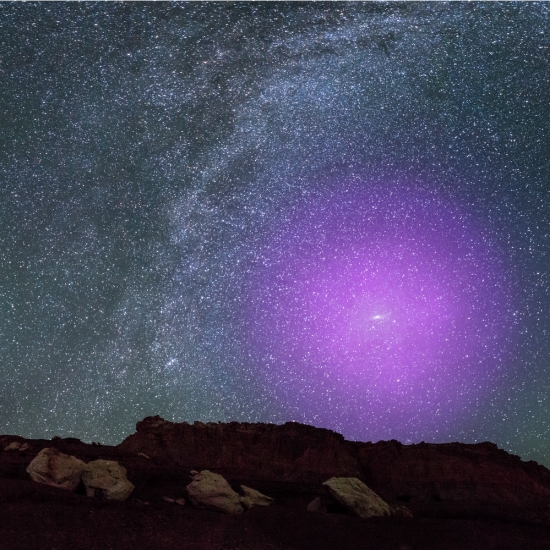
Image: At a distance of 2.5 million light-years, the majestic spiral Andromeda galaxy is so close to us that it appears as a cigar-shaped smudge of light high in the autumn sky. If its gaseous halo could be seen with the naked eye, it would be about three times the width of the Big Dipper—easily the biggest feature on the nighttime sky. Credit: NASA, ESA, J. DePasquale and E. Wheatley (STScI) and Z. Levay.
Sometimes it’s necessary to step back from the minutiae of nearby exoplanet research to see the broader perspective afforded by these cities of stars. Lehner’s co-researcher Samantha Berek (Yale University) calls haloes like these “reservoir[s] of gas” that contain the stuff of future star formation, including the outflows from supernovae. That makes a galactic halo a laboratory for its future evolution, and given its size in our sky, there is no better place to study the phenomenon than Andromeda. Indeed, the team has already found the telltale signs of heavy elements in the halo here, the result of stellar explosions that will seed new worlds.
But despite its relative proximity, how do we go about studying something as diffuse as a galactic halo? AMIGA looks at the light of 43 quasars, those brilliant cores of active galaxies that can be seen in objects much further away than M31. The method: Work with background quasar light as filtered through the Andromeda halo and examine the patterns of absorption in different regions. The data come from Hubble’s Cosmic Origins Spectrograph (COS), working on quasar light in the ultraviolet, a wavelength absorbed by Earth’s atmosphere.
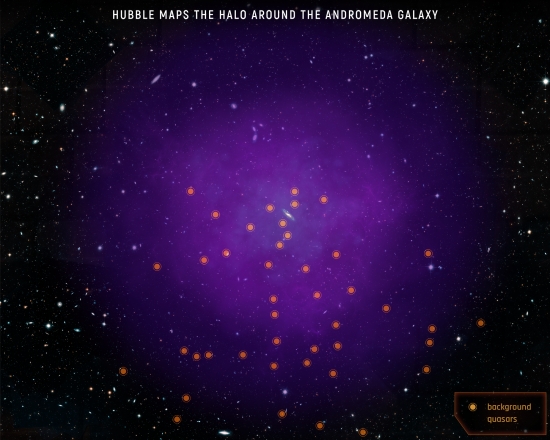
Image: This illustration shows the location of the 43 quasars scientists used to probe Andromeda’s gaseous halo. These quasars—the very distant, brilliant cores of active galaxies powered by black holes—are scattered far behind the halo, allowing scientists to probe multiple regions. Looking through the immense halo at the quasars’ light, the team observed how this light is absorbed by the halo and how that absorption changes in different regions. By tracing the absorption of light coming from the background quasars, scientists are able to probe the halo’s material. Credit: NASA, ESA, and E. Wheatley (STScI).
Ionized gas from carbon, silicon and oxygen turn up in these data, the signature of radiation stripping electrons from atoms. The new maps tune up work Lehner and colleagues performed in 2015, when the Andromeda halo’s complexity was still unknown. Fellow Notre Dame scientist Christopher Howk comments on the scope of the new study:
“Previously, there was very little information—only six quasars—within 1 million light-years of the galaxy. This new program provides much more information on this inner region of Andromeda’s halo. Probing gas within this radius is important, as it represents something of a gravitational sphere of influence for Andromeda.”
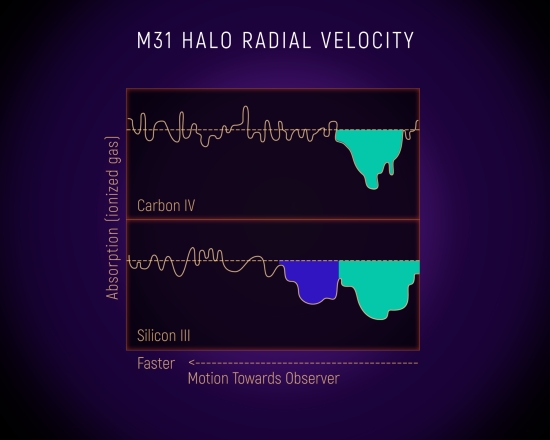
Image: This diagram shows the light from a background quasar passing through the vast, gaseous halo around the neighboring Andromeda galaxy (M31), as spectroscopically measured by the Hubble Space Telescope. The colored regions show absorption from two components that make up the halo. For ionized silicon, a significant absorption is shown in both plots. The more highly ionized carbon is absorbed by only one component. Astronomers can tell the two components apart because their line-of-sight motions, known as radial velocity, cause a Doppler shift that changes the wavelength of light being absorbed. Credit: NASA, ESA, and E. Wheatley (STScI).
The size and nearness of Andromeda thus pay off for the study of galactic haloes. Astronomers have examined them in more distant galaxies, but their distance means that there are far fewer background quasars that line up to allow analysis of the haloes. Here we have the kind of extensive sampling from which we can draw meaningful conclusions, using not just one or perhaps two sightlines but over 40, according to Lehner. Future space telescopes working in the ultraviolet will begin to extend such studies beyond the 30 galaxies of the Local Group.
The paper is Lehner et al., “Project AMIGA: The Circumgalactic Medium of Andromeda,” Astrophysical Journal, Volume 900, Number 1 (27 August 2020). Abstract.

What If SETI Finds Something, Then What?
Beyond its immediate cultural and philosophical implications, the reception of a signal from another civilization will call for analysis across all academic disciplines as we try to make sense of it. Herewith a proposal for an Interstellar Communication Relay, both data repository and distribution system designed to apply worldwide resources to the problem. Author Brian McConnell is an American computer engineer who has written three technical books, two about SETI (the search for extraterrestrial intelligence), and one about electric propulsion systems for spacecraft. The latter, A Design for a Reusable Water-Based Spacecraft Known as the Spacecoach (Springer, 2015) has been the subject of extensive discussion on Centauri Dreams (see, for example, Brian’s A Stagecoach to the Stars, and Alex Tolley’s Spaceward Ho!). Brian has also published numerous peer reviewed scientific papers and book chapters related to SETI, and is an expert on interstellar communication systems and on translation technology. His new paper on the matter is just out.
by Brian McConnell

SETI organizations understandably focus most of their efforts on the initial step of detecting and vetting candidate signals. This work mostly involves astronomers and signal processing experts, and as such involves a fairly small group of subject matter experts.
But what if SETI succeeds in discovering an information bearing signal from another civilization? The process of analyzing and comprehending the information encoded in an extraterrestrial signal will involve a much broader community. Anyone with a computer and a hypothesis to test will be able to participate in this effort. I would wager that the most important insights will come from people who are not presently involved in SETI research. What will that process look like?
The first step following the detection of an extraterrestrial signal will be to determine if the signal is modulated to transmit information. Let’s consider the case of a pulsed laser signal that optical SETI (OSETI) instruments look for. This type of signal consists of a laser that emits very bright but very short pulses on nanosecond time scales. By transmitting very short pulses, the laser can outshine its background star while it is active, and without requiring excessive amounts of energy. OSETI detectors work by counting individual photons as they arrive. Photons from the background star will be randomly distributed over time, while the pulsed signal’s photos will arrive in tight clusters.
This type of signal can be modulated to transmit information in several ways. The duration of each pulse can be altered, as can the time interval between pulses. The transmitter can also transmit on several different wavelengths (colors) to further increase the data rate of the combined signal.
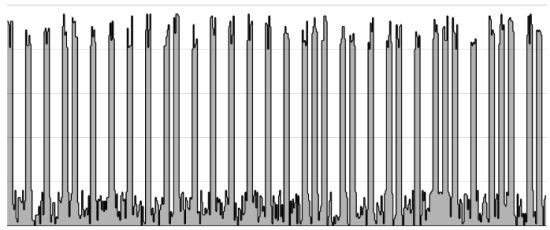
Image: Pulse interval modulation varies the delay between individual pulses.
This type of modulation will be easy to see with currently deployed OSETI detectors, so it is possible that in the case of an OSETI detection, we would also be able to extract data from the signal right away.
How much information can be encoded in an OSETI signal that is also designed to be easy to detect? We can calculate the transmission rate as follows.
![]()
Let’s work an example as follows. The signal has 20 distinct color channels and chirps on average about ten times per second. Each pulse can have a duration of 1, 2, 3 or 4 nanoseconds, and so it encodes two bits of information in the pulse width. The interval between pulses can have 256 unique values, and so it encodes 8 bits of information in the pulse interval. Plugging these numbers into the equation, we get 2,000 bits per second. While this is glacially slow compared to high speed internet connections, this works out to 172 megabits of data per day, or 21.6 megabytes per day. At this rate, the sender could transmit several thousand high resolution images per year.
The Interstellar Communication Relay, described in a recently published paper in the International Journal of Astrobiology, is a system that will be deployed in the event of a detection of an information bearing signal. It is modeled off the Deep Space Network, although it will be much less expensive to build and operate, as it will use virtualized / cloud based computing and data transfer services. The ICR will enable millions of amateur and professional researchers worldwide to obtain data extracted from an ET signal, and to participate in the analysis and comprehension effort that will follow the initial detection.
What type of information might we encounter in an alien transmission? This is anyone’s guess, and that is why it will be important to have a broad range of people and expertise represented in the message analysis and comprehension effort. Anything that can be represented in a digital format could potentially be included in a transmission.
Let’s consider images. A civilization that is capable of interstellar communication will, by definition, be proficient at astronomy and photography. Images are trivially easy to encode in a digital communication channel. Images are an interesting medium because they are easy to encode, and can represent objects and scenes on microscopic to cosmological scales. Certain types of images, such as planetary images, will be especially easy to recognize, and can be used to calibrate the decoding process on the receiver’s end.
The bitstream below is an example of what an undecoded image might look like in a raw binary stream. The receiver only needs to guess the number of pixels per row to see the image in its correct aspect ratio. This image is encoded with nine bits per pixel, with the nine bits arranged in 3×3 cells, so the undecoded image appears in its correct aspect ratio. Even before the image is decoded, it is obvious that it depicts a spheroid object against a black background, which is what a planetary image will look like,
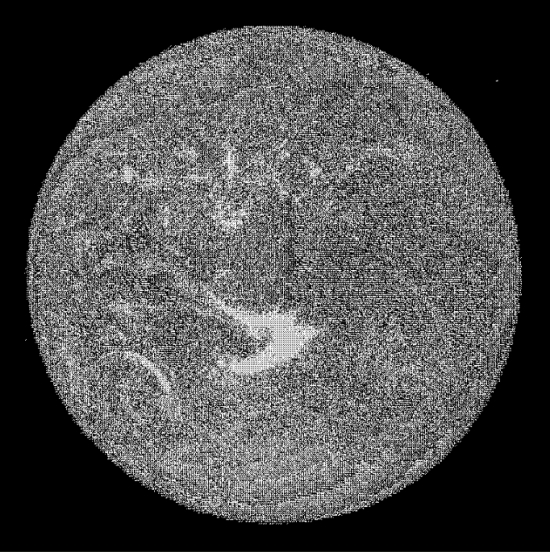
The receiver only needs to work through a small number of parameters to decode the image successfully, and once they have learned the transmitter’s preferred encoding scheme(s), they will be able to decode arbitrarily complex images. Because planetary images have well understood properties, the receiver can also use these to calibrate the decoding algorithm, for example to implement non-linear brightness encodings.
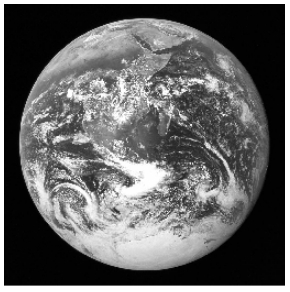
Image: The bitstream above decoded as a grayscale (monochrome) image. Credit: NASA / Apollo 17.
What about color? Color is a physical property that will be well understood by any astronomically literate civilization. The sender can assist the receiver in decoding photographs with multiple color channels by sending photographs of mutually observable objects such as nebulae.

Image: The Cat’s Eye nebula, imaged in red, green and blue color channels.
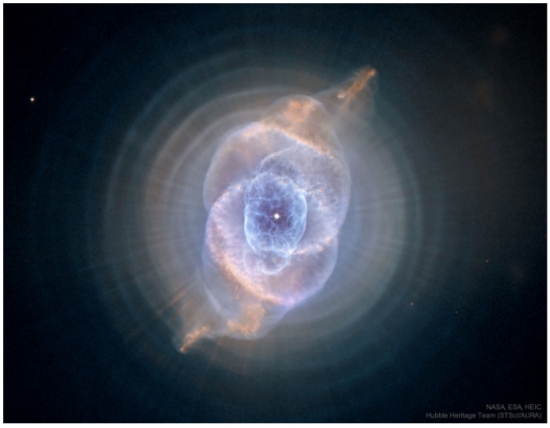
Image: Combining these color channels yields the following image. A receiver can work out which color channels were used in an image by combining them and comparing the output against images they have taken of the same object.
Images are a good example of observables. Observables, such as images and audio, are straightforward to encode digitally. Communicating qualia, internal experiences, may be quite difficult or impossible due to the lack of shared senses and experiences, but it will be possible to communicate quite a bit through observables which, in and of themselves, may be quite interesting. Photographs from another inhabited world would surely captivate scientists and the general public.
Computer programs or algorithms are another type of information to be on the watch for. Computer programs will be useful in interstellar communication for a number of reasons. The sender can describe an interpreted programming language using a small collection of math and logic symbols. While this foundation can be quite simple, with about a dozen elemental symbols, the programs written in this language can be arbitrarily complex and possibly even intelligent.
An algorithmic communication system will have a number of advantages over static content. The programs can interact with their receivers in real-time, and thus eliminate the long delays associated with two-way communication across interstellar distances. Algorithms can also make the communication link itself more reliable, for example by implementing robust forward error correction and compression algorithms that both boost the information carrying capacity of the link, and allow transmission errors to be detected and corrected without requesting retransmission of data.
Take images as an example. Lossy compression algorithms, similar to the JPEG format, can reduce the amount of information needed to encode an image by a factor of 10:1 or more. Order of magnitude improvements like this will favor the use of algorithmic systems compared to static, uncompressed data.
These are just a couple of examples of the types of information we should be on the watch for, but the range of possible information types we may encounter is much greater than that. That’s why it will be important to draw in people representing many different areas of expertise to evaluate and understand the information conveyed by an ET signal.
The paper is McConnell, “The interstellar communication relay,” International Journal of Astrobiology 26 August 2020 (abstract).

